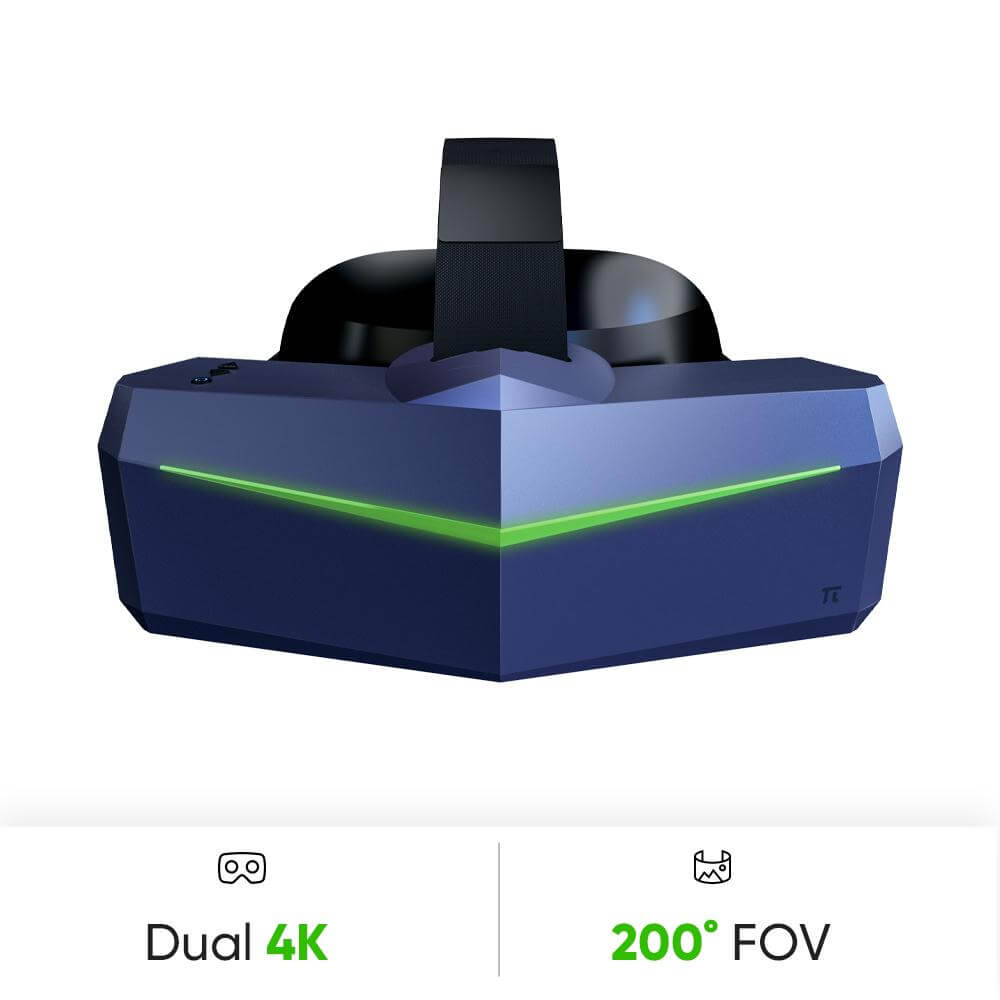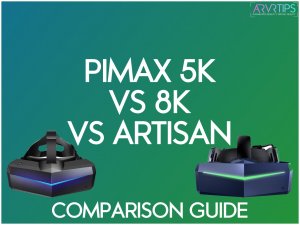Have you ever wondered about Pimax VR headsets and whether they are worth their price and specs? In this guide, we compare the Pimax 5K vs 8K vs Artisan. We’ll also look at the Plus models and break down exactly what you get with each headset.
When we’re done, you’ll have a better idea of who Pimax is and which VR headset is worth buying. You can also check out our VR Headset Comparison Tool to see how Pimax compares with other headsets.
Let’s dive in.
Other VR headset comparisons to check out (links will open in a new window):
Who is Pimax?
Pimax introduced their first VR headset back on Kickstarter on 2017. At the time, they promised video quality and a field of view unlike anything else that existed in virtual reality.
Pimax may not be as well-known as Oculus or Valve, but that’s not stopping the company from introducing new products to build up its rapport with enthusiasts. Today, the company builds elite headsets that often push the boundaries of what current PC hardware can do.
Pimax has made waves in the industry with their wide 200 degree field of view. This is wider than VR headsets from any other company.

On paper, the specs of a Pimax headset meet or exceed their competitors. At face value, there compelling reasons to choose them over other major HMDs. As we’ll break down later, the specs don’t always paint the full picture.
Next, we’ll summarize all the VR headsets currently available for sale by Pimax.
Pimax 5K XR

The Pimax 5K XR headset is the original base VR headset that the company sells. It has a resolution of 2560×1440 per eye or a total resolution of 5120×1440. The term “XR” stands for “Extended Range” for the added dynamic color range and the near absolute blacks that are possible.
The 5K XR was the original base Pimax model sold.
Pimax 5K Plus

The Pimax 5K Plus is the upgraded version of the 5K. There are two differentiating factors between the Pimax XR headset and the 5K plus.
Firstly, the the Plus utilizes CLPL instead of OLED screens. Second, the 5K Plus supports a higher refresh rate. This allows for high quality and less flicker.
Pimax Vision 8K Plus

The Pimax Vision 8K Plus is the second generation of the Pimax 8K headset. It solves earlier cable bandwidth limitations by using the highest data transmission mode with Displayport 1.4a. This allows native 4K resolution per eye, without the visual compromise from up-scaling a 5K signal.
The total native resolution of a Pimax Vision 8K Plus is 7680×2160, which should help reduce screen door effect. This model offers a dual engine mode, which can lower the render resolution and then upscale that to 4K.
Pimax Vision 8K X

The Pimax Vision 8K Plus is the upgraded version of the 8K Plus. It features two native 4K screens that provide clearer picture than the Plus. It also has a higher refresh rate too.
Pimax Artisan

The Pimax Artisan is the right headset if you can’t justify the price of the 5K or 8K. The Artisan promises a 140 degree field of view, 1600×1440 per eye resolution, and three supported refresh rates: 72Hz, 90Hz, and 120Hz. It uses Pimax’s patented CLPL panel, similar to LCD.
The Artisan has full support for SteamVR Tracking though. This means you should be able to add positional tracking and Index controllers from Valve. If you already own an HTC Vive, you should be able to upgrade just the headset by buying an Artisan and using your existing base stations and controllers.
If you are confused about the Pimax 5K vs 8K and all of the sub-models, you aren’t alone. One of the biggest complaints is the confusion in the models.
Below, we’ll break down the specifications of each in a nice chart.
Pimax 5K vs 8K vs Artisan Specifications
We have put together a table to highlight the differences and similarities between these 5 headsets from Pimax. Also, below the table, we highlighted some important facts.
| Specifications | 5K XR | 5K Plus | Vision 8K X | Vision 8K PLUS | Pimax Artisan |
| Screen | OLED | CLPL | CLPL | CLPL | CLPL |
| Resolution | 2560 X 440 | 2560 X 440 | 3840X2160 | 3840×2160 | 1700×1440 |
| Delay | 15ms | <15ms | <15ms | <15ms | <10ms |
| Refresh rate | Monocular 85Hz | Single eye – 90HzDouble eye – 180Hz | Single eye – 90HzDouble eye – 180Hz | 90Hz | 120Hz |
| Field of view | 200 degrees | 200 degrees | 200 degrees | 200 degrees | 140 degrees |
| Audio | 3.5mm standard headphone jack | 3.5mm standard headphone jack | 3.5mm standard headphone jack | 3.5mm standard headphone jack | 3.5mm standard headphone jack |
| Connection | USB 2.0/3.0 | USB 2.0/3.0 | USB 2.0/3.0 | USB 2.0/3.0 | USB 2.0/3.0 |
| Sensor | Gravity sensor Gesture tracking Gyroscope | Gravity sensor Gesture tracking Gyroscope | Gravity sensor Gesture tracking Gyroscope | Gravity sensor Gesture tracking Gyroscope | Gravity sensor Gesture tracking Gyroscope |
| Ergonomics | Adjustable strap Face sponge Adjustable distance knob | Adjustable strap Face sponge Adjustable distance knob | Adjustable strap Face sponge Adjustable distance knob | Adjustable strap Face sponge Adjustable distance knob | Adjustable strap Face sponge Adjustable distance knob |
| Recommended Configuration | GTX 1070 or higher | GTX 1070 or higher | GTX 1070 or higher | GTX 1070 or higher | GTX 1050/1060 Ti or higher |
Resolution
All Pimax 5K models have the same resolution. Likewise, all Pinax 8K models are also the same. The Pimax Artisan has a lower resolution than the rest.
The 5K XR has an OLED screen which offers a high and bright contrast display. The other Pimax headsets offer patented CLPL screens, which are similar to LCD.
Field of View (FOV)
The field of view is the extent of the observable world that is seen at any given moment using a headset. All the headsets offer 200 degree field of view (FOV), except Pimax Artisan which comes with a field of view of 140 degrees horizontally.
Price
The 5K XR and Vision 8K Plus come at a price tag of $899, which is higher than the 5K plus at a price tag of $699. The Vision 8K X is the most expensive of the 5 headsets with a price tag of $1,299. The Pimax Artisan is the cheapest, which comes at a price tag of $449.
Release Date
2019 was a year Pimax launched 4 headsets – the 5K plus, 5K XR, Vision 8K X, and Vision 8K Plus. The 5K Plus and 5K XR were released in February and May 2019 respectively. The Vision 8K Plus and Vision 8K X were released in October and December 2019. The Pimax Artisan is the newest headset available. It was released for VR enthusiasts to start buying in January 2020.
Recommended PC Specs
All Pimax VR headsets have the same recommended PC specs:
- Windows 8 or 10
- Nvidia GTX 1070
- 8 GB RAM
- DisplayPort 1.4
The recommended specs for the Pimax Artisan are slightly less. It supports the GTX 1050 or 1060 Ti.
Next, we break down the Pimax 5K vs 8K vs Artisan in even more detail!
Pimax 5K vs 8K vs Artisan Reviews
5K XR Review
One of the biggest criticisms of VR today is that it feels like putting on a pair of ski goggles. You end up with unnatural black circle around the periphery of your vision. The Pimax 5K is a new breed of “ultra wide” field of view headsets. When you wear it, it takes up almost your entire vision, rendering a scene as accurate as real life. It’s a tantalizing glimpse into the future of VR.
It also comes with an OLED screen which offers the benefits of those lovely super-blacks and popping colors. The lenses and canted panels are absolutely massive. There’s a large sweet spot, and the displays are crisp.The 5K XR headset is a great headset for the money.
It features PiTool, which lets you play VR games from SteamVR and Oculus.
Be aware that the base cost of the Pimax 5K XR by itself is only for the headset. For a working VR experience, you’ll also need at least one Steam VR Lighthouse Basestation and motion controllers. Also, If you wear glasses, wait until they’ve fixed the comfort issues.
Pros
- Field of View allows for best immersion
- Super-blacks and colors from OLED displays
- High visual clarity with the right settings
- Peripheral vision
- Lightweight
Cons
- Fragile build with poor head strap
- Headphones not included
- Screen Door Effect compared to LCD
Pimax 5K Plus Review
The Pimax 5K Plus has most of the same specs as the 5K XR. The only difference is that the Plus version comes with support for a higher refresh rate. This makes games run smoother and more crisp.
Vision 8K Plus ReviewThe Pimax 8K Plus is the base model of Pimax’s upper tier headset. With 8K resolution, it offers a new standard for VR clarity. The headset features twin 4K displays and backed up by a 200 degree field-of-view. That’s by far the highest FOV out of any VR headset.
It also has built-in audio jacks to support headsets and a refresh rate up to 90Hz. Like other Pimax headsets, PiTool has compatibility with Steam VR and Oculus.
The jump in clarity is obvious from the moment you’d wear the headset. Fine text is often difficult to read on competing headsets, and details can appear obscured or heavily aliased. Not so on the Pimax 8K Plus.
Pros
- Performance-driven headset
- Wide view of field
- The refresh rate is cool
Cons
- The headset seems to cause eyestrain
Vision 8K X Review
The Pimax 8K X differs in the comfort department with a wider head strap and the addition of adjustment dial in the back. There’s also some plush cushioning for the back of the head. The Pimax Vision 8K X features two panels each at 4K resolution. It is a higher total resolution than any non-Pimax VR headset available to consumers today. The display is the best for VR headsets available to consumers.
You can add hand tracking to the 8K X through a $170 module add-on. Similar to the Oculus Quest, it allows you to play games without the use of any controllers.
Pros
- Great performance
- Great resolution compared to the Vive
- Wide view of field
Cons
- Quite a bit of Distortion
- Short cable length
Pimax Artisan Review
The Pimax Artisan is the base model VR headset. For $450, the Artisan features two 1700×1440 panels with RGB with a base refresh rate of 72 Hz. Its horizontal field of view is 140 degrees and it has 6-degrees of freedom tracking.
The pricing for the PC-connected Artisan is pretty typical by today’s standards. But keep in mind that this is for the headset only. If you don’t already have them, you’ll also need to add the cost of base stations and controllers.
Pros
- More affordable
- Excellent performance
- Comes with adjustable straps
Cons
- The resolution is not as great as the other headsets.
Overall, the Pimax line of VR headsets is a promising brand to watch in the future. There are a few fixable mistakes that the company should be able to take care of for the next generation of headsets.
Do you own a Pimax VR headset? How do you think the Pimax 5K vs 8K compares to each other? Give us your review of the hardware down below in the comments section.


